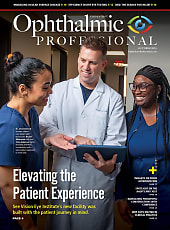The management of non-infectious uveitis requires the modulation of the immune system, with the first-line therapy often encompassing steroids in various formulations. In situations where long-term control is required, immunosuppression offers an avenue of control. Traditional medications (known as originator drugs) include anti-metabolites (methotrexate, azathioprine, mycophenolate mofetil), anti–tumor necrosis factor alpha (TNF-ɑ) inhibitors (adalimumab, etanercept, and infliximab), anti–CD20 agents (rituximab), alkylating agents (cyclophosphamide, chlorambucil), and calcineurin inhibitors (cyclosporine, tacrolimus).1
Just as in the world of retina, biosimilar medications have emerged as alternatives to traditional treatments for uveitis, with varied results. Biosimilar agents are not exact copies of preexisting originator molecules; instead, they are analogous structures designed to achieve the same result. However, the material used, structure, and manufacturing process differs from the originator drug. Understandably, there are some reservations regarding the use of biosimilars, especially concerning their safety and efficacy. This article serves as review on the recent literature comparing outcomes of biosimilars to originator drugs in the treatment of noninfectious uveitis in both pediatric and adult populations.
Pediatric Uveitis
The management of pediatric uveitis brings with it a specific set of challenges. Often, local and oral steroids are limited due to their potential complications, including glaucoma, cataract formation, and inhibition of bone development. To transition away from steroids, steroid-sparing therapy is ideal for children with chronic disease. Commonly, anti-TNF-ɑ inhibitors are preferred due to efficacy and limited side effect profile.
Overall, the literature shows comparable results between biosimilar agents and originator anti-TNF-ɑ inhibitors for pediatric patients. A large review of 47 patients (77 eyes) of biosimilar agents in pediatric patients was released in 2024.2 The study included patients using biosimilars for adalimumab, etanercept, and infliximab. In this study 27 patients (57.4%) had systemic disease associated with their uveitis, which included juvenile idiopathic arthritis, Behçet’s disease, sarcoidosis, scleroderma, or other connective tissue disorders. The remaining patients were classified as idiopathic. Forty-five eyes (58.4%) were classified as anterior, 14 eyes (18.2%) were classified as intermediate, 3 eyes (3.9%) posterior, and 15 eyes (19.5%) were panuveitis. The majority (69 eyes; 89.6%) were started on biosimilars from the onset, with the remaining 7 eyes being switched from originator drug to biosimilar.
The authors found that the patients treated with biosimilars maintained best-corrected visual acuity (BCVA), and biosimilars significantly reduced the number of ocular uveitis recurrences (284.14 flares per 100 patients/year before initiating biosimilar vs 52.34 flares per 100 patients/year after starting the biosimilar). Additionally, use of these medications enabled a significant glucocorticoid-sparing effect and reduced the number of ocular complications seen in the group.2
Another report evaluated the outcomes and cost of TNF-ɑ inhibitor biosimilars compared to reference drugs in pediatric patients. The study reviewed 19 patients—9 on infliximab, 10 on an infliximab biosimilar. In all cases, the switch to infliximab biosimilar was insurance mandated. In comparison to the reference drug, biosimilar agents carried a lower cost profile, and patients had a lower flare number per year on the biosimilar. The authors did detail that the duration of time the patients were on the biosimilar was shorter compared to the reference drug, which may have confounded the results.3
Adult Noninfectious Uveitis
Routinely, adults with chronic noninfectious uveitis are transitioned to steroid-sparing agents. Currently, adalimumab is the only treatment for noninfectious uveitis approved by the US Food and Drug Administration (FDA), although other agents are commonly used in conjunction for systemic disease control. Following the lapse of the patent for adalimumab, several biosimilars for the originator drug have emerged.
Like the pediatric literature, the outcomes of starting adult patients on biosimilars has been assessed. One report, comprised of 26 patients (47 eyes), assessed the outcomes of switching to SB5, an adalimumab biosimilar. The disease was categorized as panuveitis in most eyes (25 eyes; 53.2), with the remaining categorized as anterior (12 eyes; 25.5%) or posterior (10 eyes; 21.3%). Behçet’s was the most common disease process (8 eyes), followed by spondyloarthritis (5 eyes), Vogt-Koyanagi-Harada, enteropathic arthritis, and sarcoidosis.
The authors found that the biosimilar was effective in reducing the uveitis relapse rate, occurrence of retinal vasculitis, and cystoid macular edema. Further, the biosimilar allowed for an improvement in visual acuity and a significant glucocorticoid-sparing effect. The group displayed a strong drug retention rate, at almost 92%.4 In another review of 102 patients switched to adalimumab biosimilars, it was shown that the flare rate was not significantly different between the 2 groups. Interestingly, 24 patients requested a switch back to the originator drug, due to side effects occurring at the site of injection or difficultly with the injector.5
Other reports have assessed the outcomes of switching patients from originator drug to biosimilars. One group assessed the rates of noninfectious uveitis flare rates in those switched from TNF-ɑ inhibitors to biosimilars in 37 patients (62 eyes). During the 12-month follow-up period after the switch, there was no statistically significant difference in flares rates.6 A separate analysis was done on 48 patients with Behçet’s uveitis who were transitioned to a biosimilar for adalimumab after failing other types of immunosuppression. It is important to note that these patients were all anti–TNF-ɑ naïve. Visual acuity and anterior chamber cell grade both significantly improved. Macular edema also improved, but it was not statistically significant.7
Similarly to adalimumab biosimilars, good control was achieved in an analysis of 14 patients treated with an infliximab biosimilar.8 Interestingly, a separate assessment of 17 patients switched from infliximab to an infliximab biosimilar experienced more flares per person-years after switching, with the majority of patients who flared experiencing a flare within 90 days of switching. The authors concluded that those switched to infliximab biosimilars experienced a higher rate of flares than those on the originator drug, especially within the first 90 days.9
Conclusion
The current literature shows similar outcomes as compared to the originator drug in most patients. Further research is needed to elucidate which patients will do well when switched to biosimilar drugs, and which types of uveitis should be kept on originator medications. RP
References
1. Jabs DA, Rosenbaum JT, Foster CS, et al. Guidelines for the use of immunosuppressive drugs in patients with ocular inflammatory disorders: recommendations of an expert panel. Am J Ophthalmol. 2000;130(4):492-513. doi:10.1016/s0002-9394(00)00659-0
2. Tarsia M, Vitale A, Gaggiano C, et al. Effectiveness and safety of biosimilars in pediatric non-infectious uveitis: real-life data from the International AIDA Network uveitis registry. Ophthalmol Ther. 2024;13(3):761-774. doi:10.1007/s40123-023-00863-1
3. Valikodath NG, Rathinavelu J, Deaner JD, Buckley M, Grewal DS. Comparison of reference and biosimilar medications for pediatric noninfectious uveitis. Int Ophthalmol Clin. 2024;64(4):69-73. doi:10.1097/iio.0000000000000530
4. Sota J, Gentileschi S, Vitale A, et al. Effectiveness of SB5, an adalimumab biosimilar, in patients with noninfectious uveitis: a real-life monocentric experience. Asia Pac J Ophthalmol (Phila). 2021;10(4):360-365. doi:10.1097/apo.0000000000000380
5. Murray GM, Griffith N, Sinnappurajar P, et al. Clinical efficacy of biosimilar switch of adalimumab for management of uveitis. Ocul Immunol Inflamm. 2024;32(4):442-446. doi:10.1080/09273948.2023.2172591
6. Fabiani C, Vitale A, Emmi G, et al. The role of biosimilars in uveitis: long-term real-world outcomes of the switch from original to biosimilar TNF-alpha inhibitors. Front Pharmacol. 2019;10:1468. doi:10.3389/fphar.2019.01468
7. Soheilian M, Ebrahimiadib N, Hedayatfar A, Hosseini M, Zarei M, Anjidani N. Efficacy of biosimilar adalimumab in the treatment of Behçet’s uveitis. Ocul Immunol Inflamm. 2022;30(6):1495-1500.
doi:10.1080/09273948.2021.1900276
8. Zaguia F, Randerson EL, Moorthy RS, Goldstein DA. Efficacy of biosimilar infliximab-dyyb in non-infectious uveitis. Ocul Immunol Inflamm. 2024;32(8):1517-1521. doi:10.1080/09273948.2023.2244071
9. Deaner JD, Srivastava SK, Hajj-Ali RA, et al. Recurrence rates of inflammation after switching from the originator infliximab to biosimilar infliximab-abda for noninfectious uveitis. Am J Ophthalmol. 2021;225:172-177. doi:10.1016/j.ajo.2020.08.005









